
I'm a Young "Polish" Architect!
How young architects live in Poland...
On January 12, 2006, a vernissage took place at CCEA (Centre for Central European Architecture) for the fourth exhibition from the Young Blood / Mladá krev cycle, which this time presents the work of the youngest active architectural generation in Poland.
The Young Blood project is a curatorial initiative of the Prague CCEA and is based on the very appealing idea of confronting the views of young architects from Central Europe, their approaches to understanding the architectural profession, and its practical functioning in their respective countries. The charm of the idea lies in the fact that understanding our immediate neighbors and their work can help us much better identify our own style in the context of Europe and the whole world.
The Young Blood cycle was launched in June 2004 with the exhibition I'm a Young "Czeck" Architect!, followed in 2005 by the Slovak exhibition I'm a Young "Slowak" Architect!, and the Slovenian exhibition I'm a Young "Sloven" Architect!. The organizers aim not only to present individual studios and their installations but also to map the overall situation in the field of architecture in individual countries.
At the exhibition I'm a Young "Pollish" Architect!, six Polish architectural studios are presented, selected by the CCEA curatorial team. The individual studios have brought a number of very interesting ideas into their projects, often expressing a very personal perspective on the situation of the young architect in their environment. The individual installations are connected by several common themes. A clear theme that permeates all the works is the issue of the architect-client-investor relationship.
Such interesting ideas certainly deserve to be articulated better. Regarding the individual installations, it can be said that they possess an interesting concept, which was fulfilled with varying degrees of perfection. It is also interesting to observe how individual installations fared in the space, which is limited in certain ways, and the authors of the installations did not know it in advance. And how they would likely fare in much more dignified spaces, in large galleries, or directly in the city, where architecture belongs.
For example, the installation by 2CH Architekci retains its appeal in every environment; the materials used—sand and wind—validate the words of Bartosz Haduch, who cites Eastern countries as one of the inspirational sources for the studio. The project by the studio Cechownia also presents a strong concept that can withstand any space due to its play of light and an effort to draw the viewer into the narrative (polystyrene balls that must be lifted to glimpse the secrets of architecture).
List of exhibiting studios:
2CH Architekci (Aleksandra Witeczek, Bartosz Haduch)
Cechownia (Aleksandra Grzonka, Ewa Malec)
CH+Architekt (Agnieszka Chrzanowska, Wojtek Chrzanowski)
RRA Roman Rutkowski (Roman Rutkowski)
Stanislawski.Wojciechowski.Mnich (Sebastian Stanisławski, Łukasz Wojciechowski, Marta Mnich)
T-33 (Wojciech Adam Zaborniak, Tomasz Bogdan Skrobun)
The exhibition will be open until March 5, 2006.
The architectural studio 2CH Architekci, which focuses on architecture, urbanism, design, and graphics, was founded in 2005 by Bartosz Haduch and Aleksandra Witczech.
In the presented installations, we can find one common theme that runs through them like a red thread. That theme is: The problems that young architects in Poland must face. What do you perceive as your biggest obstacle?
For us, there are no problems, only challenges :)
In the individual projects, we often encounter the words "Client" and "Investor." These are the tasks that architects face every day. During their studies, architects are not prepared at all for these tasks. What is the situation in Poland?
The situation in Poland is very similar. The problem after graduation is also the lack of relevant knowledge related to construction law, procedures, and regulations. To a large extent, we gain experience through our own projects, mostly after finishing our studies.
Architects in the Czech Republic mostly compare their work again with Czech architects (with the thought that the world standards are entirely different). How is it in Poland? And how has your participation in the Young Blood project influenced you in this regard?
We travel a lot (in 2005 alone, Japan, India, and various European countries) and have lived in different places (Spain, Austria, Germany, Holland). Thus, we have comparisons with various cultures and architectures from around the world. Experiences from visits and living in other countries are one of our most important sources of inspiration. Since 2001, I have been writing articles on world architecture (which have been published in Poland, Italy, and China). This gives us a good perspective and comparison. The work of 2CH Architekci is more global than Polish.
What prompted your decision to participate in the Young Blood project?
We wanted to create something abstract, a poetic project—an installation that lies somewhere on the border between architecture and design. Because a limited space was made available for each installation, we could create a temporary project using materials and objects in unusual ways.
Did the project meet your expectations?
Yes. We were satisfied with the reactions of people trying to touch the sand and feel the wind in our installation. The only downside was the limited space for the installation. Next time, we would like to create a much larger sand dune.
Which Czech architects do you know?
Ivan Kroupa
ARCH.A
Kolpron
AHK
Marta Mnich & Lukasz Wojciechowski
Sebastian Stanislawski and Lukasz Wojciechowski created a joint studio in 2003 in Warsaw. They also work closely with architects Marta Minch and Monika Dziadosz, student Martin Lopatka, and a wide range of specialists from other professions.
In the presented installations, we can find one common theme that runs through them like a red thread. That theme is: The problems that young architects in Poland must face. What do you perceive as your biggest obstacle?
The problems in Poland seem to be the same as in other countries. I think we do not encounter more or fewer obstacles compared to other European architects.
We do not perceive our projects as helpless expressions of problems, but rather as our irony over them. We do not say we are paralyzed by problems, but rather that we are trying to creatively solve them—architecture for us means constantly solving problems, not creating them.
On the other hand, looking to the west, we can see that our architecture, i.e., clients, judges of competitions, authorities, and also architects are slightly behind. The problem is, as can be clearly seen in Poland, that in post-communist countries, the history of architecture is condensed into a much shorter time span than in the old EU countries. Here, Postmodernism is still relevant in certain circles.
What is the most complicated? In fact, we have more and more competitions, better juries, and we can slowly see how our streets are changing. We think that architects (including us) like to complain about others (clients, judges, etc.) and do not see our own mistakes. We (the young among us) do not meet, do not discuss, and often stop learning architecture after graduation. We think the most significant problem lies within ourselves, as we often do not have any better communication than to propose "modern," overly formal buildings.
In the individual projects, we often encounter the words "Client" and "Investor." These are the tasks that architects face every day. During their studies, architects are not prepared at all for these tasks. What is the situation in Poland?
No one teaches us communication with the client either. More precisely, no one teaches us to talk about projects at all. Often, the verbal expression of a project (for example, in competitions) is so sophisticated and indirect that after a few words, you lose the content.
It is really funny, but when we talk to our architect friends, we often realize that we should learn design first and then negotiation. But seriously, sometimes we are amazed at how much of the quality of architecture depends on the art of expression.
Architects in the Czech Republic mostly compare their work again with Czech architects (with the thought that the world standards are entirely different). How is it in Poland? And how has your participation in the Young Blood project influenced you in this regard?
It seems that it is the same in Poland. But the young generation is opening up to the world.
We read international magazines, visit websites, etc.
The problem for us is that we are so influenced by what is called "Wallpaper architecture."
Although fortunately, most of the young generation has turned away from historical postmodernism—instead, it seems, they are stuck in the picturesque aesthetics of rediscovered Modernism or simply copy the architectural stars, without any understanding of their ideas.
We think the problem is that we see the world but cannot read it.
What prompted your decision to participate in the Young Blood project?
Our reaction to the exhibition was enthusiastic, as we are just as interested in architecture as we are in discussing it.
The idea of CCEA not to hang panels on the wall but to exhibit models forced us to think and create an installation. It was an opportunity and a challenge for us.
It made us think about what interesting we are able to communicate to the Czech audience about the reality of the Polish architect. We realized that we probably have the same problems and wishes.
With our installation (red and white tape cut into flags), we only wanted to provide an ironic answer to the question—what is so Polish about Polish architecture?—which is represented here by an empty building plot.
Did the project meet your expectations?
Yes, we were very satisfied with the CCEA project.
Which Czech architects do you know?
We know some, but not many. And not by name, except for Vladimír Šlapeta and Eva Jiřičná. We know some buildings by foreign architects in the Czech Republic and a few buildings by Czech architects such as Carrefour in Prague, Pszczolkovi House, some residential buildings, and objects that we just saw during our visit to CCEA in Prague.
We have a certain idea of the Czech architectural scene thanks to visiting the Archiweb portal.
RRA Roman Rutkowski
The establishment of the RRA studio was initiated by Roman Rutkowski in 2000. Other young architects working in the studio include Agnieszka Rutecka, Gawel Tyrala, and Tomasz Zaleski.
In the presented installations, we can find one common theme that runs through them like a red thread. That theme is: The problems that young architects in Poland must face. What do you perceive as your biggest obstacle?
The limits of my own talent and knowledge. If these two functions properly, everything goes more or less smoothly.
In the individual projects, we often encounter the words "Client" and "Investor." These are the tasks that architects face every day. During their studies, architects are not prepared at all for these tasks. What is the situation in Poland?
The situation is the same in Poland. However, as an academic teacher in Warsaw, I am still trying to incorporate this issue into the educational process.
Architects in the Czech Republic mostly compare their work again with Czech architects (with the thought that the world standards are entirely different). How is it in Poland? And how has your participation in the Young Blood project influenced you in this regard?
It's the same story—if architects know anything about others, they are mostly their Polish colleagues. There are, of course, exceptions.
What prompted your decision to participate in the Young Blood project?
The need for an exchange of experiences with another country—we, between the two countries, need to communicate with each other. (And we also need to promote ourselves, of course!)
Did the project meet your expectations?
Yes
Which Czech architects do you know?
Milan Rak (I don't even remember how many times I have visited Rudník!), HŠH, A69. And my best friend Osama Okamura! I regularly follow the website archiweb.cz.
t-33 tom&wojciech
The architectural studio was founded in May 2004. It engages in architectural activities and related activities. Main activities: architectural and urban design, modeling and computer visualizations, graphics.
In the presented installations, we can find one common theme that runs through them like a red thread. That theme is: The problems that young architects in Poland must face. What do you perceive as your biggest obstacle?
The biggest problems arise from the accessibility of the construction market, the caste system, and the business system associated with this sector. It seems that natural development should involve participation in competitions.
However, the organizational mechanism of many of them creates formal limits that ultimately discriminate against young architects with little practice.
In the individual projects, we often encounter the words "Client" and "Investor." These are the tasks that architects face every day. During their studies, architects are not prepared at all for these tasks. What is the situation in Poland?
As much as possible, this problem affects young architects in the Czech Republic just as in Poland.
In the entire educational process, there is still no space for subjects that would simulate the relationship between the client and the architect.
Such knowledge is only gained through experience during work after graduation. We perceive this problem as very important because we know how much inconvenience a lack of these skills can cause at the beginning of our professional careers.
Architects in the Czech Republic mostly compare their work again with Czech architects (with the thought that the world standards are entirely different). How is it in Poland? And how has your participation in the Young Blood project influenced you in this regard?
We are constantly in contact with Western architectural studios, doing a lot of work for them and often collaborating on various commitments. We are confident that we can produce a product of very high quality, which is why we do not suffer from a "Western world complex."
Our collaboration allows us to better estimate the implementation capabilities of Western architects in areas such as self-promotion, education, etc., and simultaneously the possibilities of realizing more sophisticated architecture.
What prompted your decision to participate in the Young Blood project?
The desire to confront ourselves in front of the public through the realization of a sculptural object and, of course, the competitive form of this commitment.
We do not hide that for us this is, in a certain way, a prestigious performance that places us in a different position than that of the architect—craftsman.
Did the project meet your expectations?
The project was evaluated for a very long time and differs significantly from the original version. It is only the form that we can accept, and which met our expectations. We decided to create it with our own hands, so the only doubts that may arise concern the technology we used for the realization.
Which Czech architects do you know?
Unfortunately, we do not know any Czech architects. However, we believe that our participation in the exhibition and contacts with CCEA will initiate an exchange of information and opinions. We hope that it will help us get a better understanding of this community, which is very interesting to us!
The Young Blood project is a curatorial initiative of the Prague CCEA and is based on the very appealing idea of confronting the views of young architects from Central Europe, their approaches to understanding the architectural profession, and its practical functioning in their respective countries. The charm of the idea lies in the fact that understanding our immediate neighbors and their work can help us much better identify our own style in the context of Europe and the whole world.
The Young Blood cycle was launched in June 2004 with the exhibition I'm a Young "Czeck" Architect!, followed in 2005 by the Slovak exhibition I'm a Young "Slowak" Architect!, and the Slovenian exhibition I'm a Young "Sloven" Architect!. The organizers aim not only to present individual studios and their installations but also to map the overall situation in the field of architecture in individual countries.
At the exhibition I'm a Young "Pollish" Architect!, six Polish architectural studios are presented, selected by the CCEA curatorial team. The individual studios have brought a number of very interesting ideas into their projects, often expressing a very personal perspective on the situation of the young architect in their environment. The individual installations are connected by several common themes. A clear theme that permeates all the works is the issue of the architect-client-investor relationship.
Such interesting ideas certainly deserve to be articulated better. Regarding the individual installations, it can be said that they possess an interesting concept, which was fulfilled with varying degrees of perfection. It is also interesting to observe how individual installations fared in the space, which is limited in certain ways, and the authors of the installations did not know it in advance. And how they would likely fare in much more dignified spaces, in large galleries, or directly in the city, where architecture belongs.
For example, the installation by 2CH Architekci retains its appeal in every environment; the materials used—sand and wind—validate the words of Bartosz Haduch, who cites Eastern countries as one of the inspirational sources for the studio. The project by the studio Cechownia also presents a strong concept that can withstand any space due to its play of light and an effort to draw the viewer into the narrative (polystyrene balls that must be lifted to glimpse the secrets of architecture).
List of exhibiting studios:
2CH Architekci (Aleksandra Witeczek, Bartosz Haduch)
Cechownia (Aleksandra Grzonka, Ewa Malec)
CH+Architekt (Agnieszka Chrzanowska, Wojtek Chrzanowski)
RRA Roman Rutkowski (Roman Rutkowski)
Stanislawski.Wojciechowski.Mnich (Sebastian Stanisławski, Łukasz Wojciechowski, Marta Mnich)
T-33 (Wojciech Adam Zaborniak, Tomasz Bogdan Skrobun)
The exhibition will be open until March 5, 2006.
And how do young architects live in Poland?
Bartosz Haduch, 2CH Architekci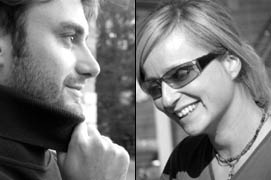 |
The architectural studio 2CH Architekci, which focuses on architecture, urbanism, design, and graphics, was founded in 2005 by Bartosz Haduch and Aleksandra Witczech.
In the presented installations, we can find one common theme that runs through them like a red thread. That theme is: The problems that young architects in Poland must face. What do you perceive as your biggest obstacle?
For us, there are no problems, only challenges :)
In the individual projects, we often encounter the words "Client" and "Investor." These are the tasks that architects face every day. During their studies, architects are not prepared at all for these tasks. What is the situation in Poland?
The situation in Poland is very similar. The problem after graduation is also the lack of relevant knowledge related to construction law, procedures, and regulations. To a large extent, we gain experience through our own projects, mostly after finishing our studies.
Architects in the Czech Republic mostly compare their work again with Czech architects (with the thought that the world standards are entirely different). How is it in Poland? And how has your participation in the Young Blood project influenced you in this regard?
We travel a lot (in 2005 alone, Japan, India, and various European countries) and have lived in different places (Spain, Austria, Germany, Holland). Thus, we have comparisons with various cultures and architectures from around the world. Experiences from visits and living in other countries are one of our most important sources of inspiration. Since 2001, I have been writing articles on world architecture (which have been published in Poland, Italy, and China). This gives us a good perspective and comparison. The work of 2CH Architekci is more global than Polish.
What prompted your decision to participate in the Young Blood project?
We wanted to create something abstract, a poetic project—an installation that lies somewhere on the border between architecture and design. Because a limited space was made available for each installation, we could create a temporary project using materials and objects in unusual ways.
Did the project meet your expectations?
Yes. We were satisfied with the reactions of people trying to touch the sand and feel the wind in our installation. The only downside was the limited space for the installation. Next time, we would like to create a much larger sand dune.
Which Czech architects do you know?
Ivan Kroupa
ARCH.A
Kolpron
AHK
Marta Mnich & Lukasz Wojciechowski
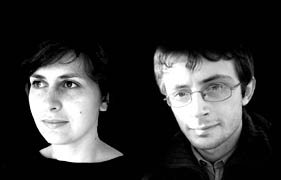 |
Sebastian Stanislawski and Lukasz Wojciechowski created a joint studio in 2003 in Warsaw. They also work closely with architects Marta Minch and Monika Dziadosz, student Martin Lopatka, and a wide range of specialists from other professions.
In the presented installations, we can find one common theme that runs through them like a red thread. That theme is: The problems that young architects in Poland must face. What do you perceive as your biggest obstacle?
The problems in Poland seem to be the same as in other countries. I think we do not encounter more or fewer obstacles compared to other European architects.
We do not perceive our projects as helpless expressions of problems, but rather as our irony over them. We do not say we are paralyzed by problems, but rather that we are trying to creatively solve them—architecture for us means constantly solving problems, not creating them.
On the other hand, looking to the west, we can see that our architecture, i.e., clients, judges of competitions, authorities, and also architects are slightly behind. The problem is, as can be clearly seen in Poland, that in post-communist countries, the history of architecture is condensed into a much shorter time span than in the old EU countries. Here, Postmodernism is still relevant in certain circles.
What is the most complicated? In fact, we have more and more competitions, better juries, and we can slowly see how our streets are changing. We think that architects (including us) like to complain about others (clients, judges, etc.) and do not see our own mistakes. We (the young among us) do not meet, do not discuss, and often stop learning architecture after graduation. We think the most significant problem lies within ourselves, as we often do not have any better communication than to propose "modern," overly formal buildings.
In the individual projects, we often encounter the words "Client" and "Investor." These are the tasks that architects face every day. During their studies, architects are not prepared at all for these tasks. What is the situation in Poland?
No one teaches us communication with the client either. More precisely, no one teaches us to talk about projects at all. Often, the verbal expression of a project (for example, in competitions) is so sophisticated and indirect that after a few words, you lose the content.
It is really funny, but when we talk to our architect friends, we often realize that we should learn design first and then negotiation. But seriously, sometimes we are amazed at how much of the quality of architecture depends on the art of expression.
Architects in the Czech Republic mostly compare their work again with Czech architects (with the thought that the world standards are entirely different). How is it in Poland? And how has your participation in the Young Blood project influenced you in this regard?
It seems that it is the same in Poland. But the young generation is opening up to the world.
We read international magazines, visit websites, etc.
The problem for us is that we are so influenced by what is called "Wallpaper architecture."
Although fortunately, most of the young generation has turned away from historical postmodernism—instead, it seems, they are stuck in the picturesque aesthetics of rediscovered Modernism or simply copy the architectural stars, without any understanding of their ideas.
We think the problem is that we see the world but cannot read it.
What prompted your decision to participate in the Young Blood project?
Our reaction to the exhibition was enthusiastic, as we are just as interested in architecture as we are in discussing it.
The idea of CCEA not to hang panels on the wall but to exhibit models forced us to think and create an installation. It was an opportunity and a challenge for us.
It made us think about what interesting we are able to communicate to the Czech audience about the reality of the Polish architect. We realized that we probably have the same problems and wishes.
With our installation (red and white tape cut into flags), we only wanted to provide an ironic answer to the question—what is so Polish about Polish architecture?—which is represented here by an empty building plot.
Did the project meet your expectations?
Yes, we were very satisfied with the CCEA project.
Which Czech architects do you know?
We know some, but not many. And not by name, except for Vladimír Šlapeta and Eva Jiřičná. We know some buildings by foreign architects in the Czech Republic and a few buildings by Czech architects such as Carrefour in Prague, Pszczolkovi House, some residential buildings, and objects that we just saw during our visit to CCEA in Prague.
We have a certain idea of the Czech architectural scene thanks to visiting the Archiweb portal.
RRA Roman Rutkowski
 |
The establishment of the RRA studio was initiated by Roman Rutkowski in 2000. Other young architects working in the studio include Agnieszka Rutecka, Gawel Tyrala, and Tomasz Zaleski.
In the presented installations, we can find one common theme that runs through them like a red thread. That theme is: The problems that young architects in Poland must face. What do you perceive as your biggest obstacle?
The limits of my own talent and knowledge. If these two functions properly, everything goes more or less smoothly.
In the individual projects, we often encounter the words "Client" and "Investor." These are the tasks that architects face every day. During their studies, architects are not prepared at all for these tasks. What is the situation in Poland?
The situation is the same in Poland. However, as an academic teacher in Warsaw, I am still trying to incorporate this issue into the educational process.
Architects in the Czech Republic mostly compare their work again with Czech architects (with the thought that the world standards are entirely different). How is it in Poland? And how has your participation in the Young Blood project influenced you in this regard?
It's the same story—if architects know anything about others, they are mostly their Polish colleagues. There are, of course, exceptions.
What prompted your decision to participate in the Young Blood project?
The need for an exchange of experiences with another country—we, between the two countries, need to communicate with each other. (And we also need to promote ourselves, of course!)
Did the project meet your expectations?
Yes
Which Czech architects do you know?
Milan Rak (I don't even remember how many times I have visited Rudník!), HŠH, A69. And my best friend Osama Okamura! I regularly follow the website archiweb.cz.
t-33 tom&wojciech
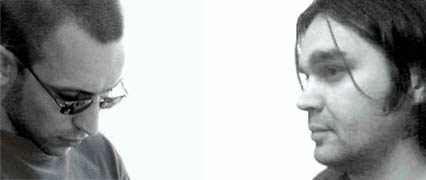 |
The architectural studio was founded in May 2004. It engages in architectural activities and related activities. Main activities: architectural and urban design, modeling and computer visualizations, graphics.
In the presented installations, we can find one common theme that runs through them like a red thread. That theme is: The problems that young architects in Poland must face. What do you perceive as your biggest obstacle?
The biggest problems arise from the accessibility of the construction market, the caste system, and the business system associated with this sector. It seems that natural development should involve participation in competitions.
However, the organizational mechanism of many of them creates formal limits that ultimately discriminate against young architects with little practice.
In the individual projects, we often encounter the words "Client" and "Investor." These are the tasks that architects face every day. During their studies, architects are not prepared at all for these tasks. What is the situation in Poland?
As much as possible, this problem affects young architects in the Czech Republic just as in Poland.
In the entire educational process, there is still no space for subjects that would simulate the relationship between the client and the architect.
Such knowledge is only gained through experience during work after graduation. We perceive this problem as very important because we know how much inconvenience a lack of these skills can cause at the beginning of our professional careers.
Architects in the Czech Republic mostly compare their work again with Czech architects (with the thought that the world standards are entirely different). How is it in Poland? And how has your participation in the Young Blood project influenced you in this regard?
We are constantly in contact with Western architectural studios, doing a lot of work for them and often collaborating on various commitments. We are confident that we can produce a product of very high quality, which is why we do not suffer from a "Western world complex."
Our collaboration allows us to better estimate the implementation capabilities of Western architects in areas such as self-promotion, education, etc., and simultaneously the possibilities of realizing more sophisticated architecture.
What prompted your decision to participate in the Young Blood project?
The desire to confront ourselves in front of the public through the realization of a sculptural object and, of course, the competitive form of this commitment.
We do not hide that for us this is, in a certain way, a prestigious performance that places us in a different position than that of the architect—craftsman.
Did the project meet your expectations?
The project was evaluated for a very long time and differs significantly from the original version. It is only the form that we can accept, and which met our expectations. We decided to create it with our own hands, so the only doubts that may arise concern the technology we used for the realization.
Which Czech architects do you know?
Unfortunately, we do not know any Czech architects. However, we believe that our participation in the exhibition and contacts with CCEA will initiate an exchange of information and opinions. We hope that it will help us get a better understanding of this community, which is very interesting to us!
The English translation is powered by AI tool. Switch to Czech to view the original text source.
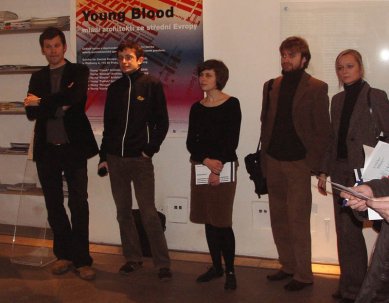
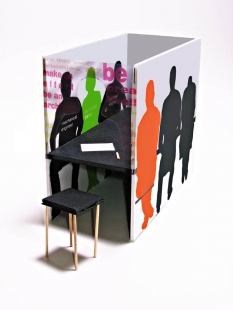
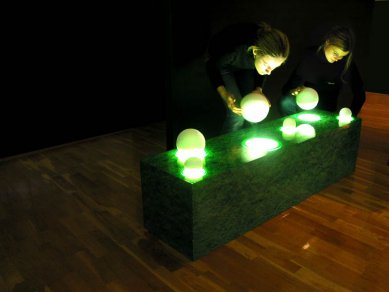
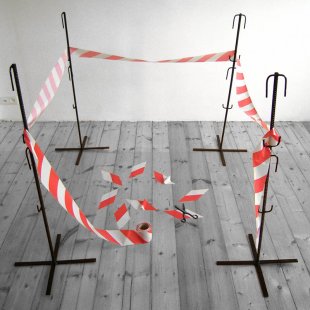
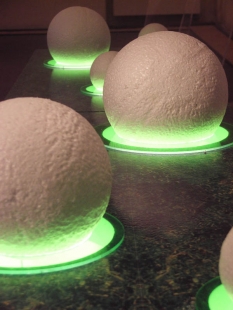
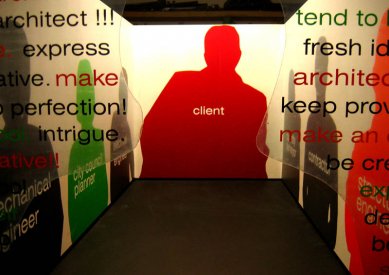
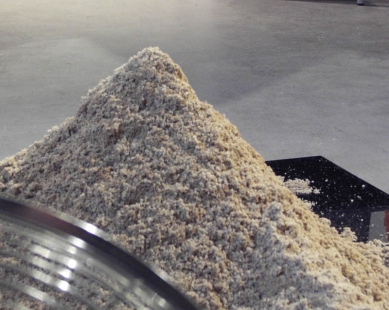
0 comments
add comment










